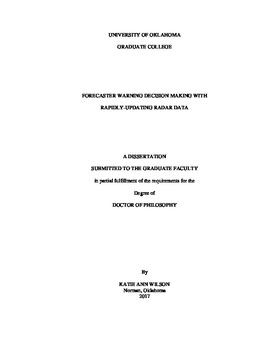| dc.description.abstract | Phased-array radar is being considered as a potential future replacement technology for the current operational Weather Surveillance Radar 1988 Doppler system. One of the most notable differences in these weather radar systems is the temporal resolution. With phased-array radar collecting volumetric updates 4–6 times more frequently, the operational impacts of rapidly-updating radar data on forecasters’ warning decision processes must be assessed. The Phased Array Radar Innovative Sensing Experiment (PARISE) was therefore designed to examine forecasters’ warning performance and related warning decision processes during use of ~1-min radar updates in simulated real-time warning operation scenarios. While the 2010, 2012, and 2013 PARISE studies reported encouraging findings for forecasters’ use of these data, each of these studies were limited in terms of sample size and the chosen methods. Additionally, important research questions that had not yet been explored remained unanswered. To address these limitations and investigate new research questions, thirty National Weather Service forecasters were invited to the NOAA Hazardous Weather Testbed to participate in the 2015 PARISE. Participating forecasters completed three components of this study: 1) the traditional experiment, 2) an eye-tracking experiment, and 3) a focus group. The first component was designed to build on previous work by assessing and comparing forecasters’ warning performance and related cognitive workload when using 1-min, 2-min, and 5-min phased-array radar updates during simulated warning operations. This traditional experiment was comprised of nine weather events that varied in terms of weather threat. Next, forecasters’ eye movement data were observed as they each worked a single weather event with either 1-min or 5-min phased-array radar updates. This work was motivated by an eye-tracking pilot study, in which a forecaster’s eye movement data was found to correspond meaningfully to their retrospective recall data that described their warning decision process. The 2015 PARISE eye-tracking experiment allowed for an objective analysis of how forecasters interacted with a radar display and warning interface for a single weather event, and more specifically, supported an investigation of whether radar update speed impacts how forecasters distribute their attention. Lastly, six focus groups were conducted to enable forecasters to share their experiences on their use of rapidly-updating phased-array radar data during the experiment. The findings from the focus groups provide motivation for the integration of rapidly-updating radar data into the forecast office and highlight some important considerations for successful use of these data during warning operations. The work presented in this dissertation was approved by the University of Oklahoma’s Office of Human Research Participant Protection Institutional Review Board under projects #5226 and #5580. | en_US |
